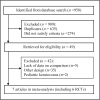Conventional and transepithelial corneal cross-linking for patients with keratoconus
- PMID: 29621306
- PMCID: PMC5886478
- DOI: 10.1371/journal.pone.0195105
Conventional and transepithelial corneal cross-linking for patients with keratoconus
Abstract
Previous studies investigating the effectiveness of conventional corneal collagen cross-linking (CXL) and transepithelial CXL in keratoconus treatment have reported conflicting outcomes. Therefore, we conducted a meta-analysis to compare the effectiveness of these treatments. We searched MEDLINE, EMBASE, and Cochrane Central Register of Controlled Trials for prospective randomized controlled trials (RCTs) with no restrictions. We included visual acuity (corrected distance visual acuity, uncorrected distance visual acuity) and corneal keratometry (K) as primary outcome parameters, and spherical equivalent, central corneal thickness (CCT), and endothelial cell density, as secondary parameters. We finally included seven reports (including six RCTs involving 305 participants and 344 eyes). Our analysis revealed significant postoperative differences in average K and CCT values between conventional and transepithelial CXL-treated patients [K: weighted mean difference (WMD) = 0.79, 95% confidence interval (CI) = 0.04-1.53, p = 0.04; CCT: WMD = 4.53, 95% CI = 0.42-8.64, p = 0.03]. In contrast, we did not find any significant differences in visual acuity, flattest K value, steepest K value, cylinder K value, apex K value, spherical equivalent, or endothelial cell density between groups. In conclusion, transepithelial CXL has a more protective influence on corneal thickness than conventional CXL, and results in lesser postoperative corneal flattening. Further investigation of the clinical outcomes of transepithelial CXL is required.
Conflict of interest statement
Figures




Similar articles
-
Efficacy and safety of transepithelial corneal collagen crosslinking surgery versus standard corneal collagen crosslinking surgery for keratoconus: a meta-analysis of randomized controlled trials.BMC Ophthalmol. 2017 Dec 28;17(1):262. doi: 10.1186/s12886-017-0657-2. BMC Ophthalmol. 2017. PMID: 29282020 Free PMC article. Review.
-
Efficacy of corneal collagen cross-linking for treatment of keratoconus: a meta-analysis of randomized controlled trials.PLoS One. 2015 May 18;10(5):e0127079. doi: 10.1371/journal.pone.0127079. eCollection 2015. PLoS One. 2015. PMID: 25985208 Free PMC article.
-
Visual rehabilitation in moderate keratoconus: combined corneal wavefront-guided transepithelial photorefractive keratectomy and high-fluence accelerated corneal collagen cross-linking after intracorneal ring segment implantation.BMC Ophthalmol. 2017 Dec 29;17(1):270. doi: 10.1186/s12886-017-0666-1. BMC Ophthalmol. 2017. PMID: 29284455 Free PMC article.
-
Accelerated Versus Conventional Corneal Collagen Cross-Linking in the Treatment of Keratoconus: A Meta-analysis and Review of the Literature.Interdiscip Sci. 2019 Jun;11(2):282-286. doi: 10.1007/s12539-019-00336-9. Epub 2019 Jun 27. Interdiscip Sci. 2019. PMID: 31250289
-
Corneal collagen cross-linking with riboflavin and ultraviolet a irradiation for keratoconus: long-term results.Ophthalmology. 2013 Aug;120(8):1515-20. doi: 10.1016/j.ophtha.2013.01.012. Epub 2013 Apr 12. Ophthalmology. 2013. PMID: 23583165
Cited by
-
Corneal collagen cross-linking epithelium-on vs. epithelium-off: a systematic review and meta-analysis.Eye Vis (Lond). 2021 Sep 1;8(1):34. doi: 10.1186/s40662-021-00256-0. Eye Vis (Lond). 2021. PMID: 34565473 Free PMC article. Review.
-
Real-time monitoring of riboflavin concentration using different clinically available ophthalmic formulations for epi-off and epi-on corneal cross-linking.Graefes Arch Clin Exp Ophthalmol. 2024 Aug;262(8):2569-2577. doi: 10.1007/s00417-024-06451-8. Epub 2024 Mar 19. Graefes Arch Clin Exp Ophthalmol. 2024. PMID: 38502352
-
The Effect of Sodium Iodide on Stromal Loading, Distribution and Degradation of Riboflavin in a Rabbit Model of Transepithelial Corneal Crosslinking.Clin Ophthalmol. 2021 May 11;15:1985-1994. doi: 10.2147/OPTH.S300886. eCollection 2021. Clin Ophthalmol. 2021. PMID: 34007152 Free PMC article.
-
Pediatric Crosslinking: Current Protocols and Approach.Ophthalmol Ther. 2022 Jun;11(3):983-999. doi: 10.1007/s40123-022-00508-9. Epub 2022 Apr 28. Ophthalmol Ther. 2022. PMID: 35482230 Free PMC article. Review.
-
Prospective 2-year study of accelerated pulsed transepithelial corneal crosslinking outcomes for Keratoconus.Eye (Lond). 2019 Dec;33(12):1897-1903. doi: 10.1038/s41433-019-0502-3. Epub 2019 Jul 4. Eye (Lond). 2019. PMID: 31273313 Free PMC article.
References
-
- Vazirani J, Basu S. Keratoconus: current perspectives. Clinical ophthalmology. 2013;7:2019–30. doi: 10.2147/OPTH.S50119 . - DOI - PMC - PubMed
-
- Romero-Jimenez M, Santodomingo-Rubido J, Wolffsohn JS. Keratoconus: a review. Contact lens & anterior eye: the journal of the British Contact Lens Association. 2010;33(4):157–66; quiz 205. doi: 10.1016/j.clae.2010.04.006 . - DOI - PubMed
-
- Wollensak G, Spoerl E, Seiler T. Riboflavin/ultraviolet-a-induced collagen crosslinking for the treatment of keratoconus. American journal of ophthalmology. 2003;135(5):620–7. . - PubMed
-
- Caporossi A, Baiocchi S, Mazzotta C, Traversi C, Caporossi T. Parasurgical therapy for keratoconus by riboflavin-ultraviolet type A rays induced cross-linking of corneal collagen: preliminary refractive results in an Italian study. Journal of cataract and refractive surgery. 2006;32(5):837–45. doi: 10.1016/j.jcrs.2006.01.091 . - DOI - PubMed
-
- Wittig-Silva C, Whiting M, Lamoureux E, Lindsay RG, Sullivan LJ, Snibson GR. A randomized controlled trial of corneal collagen cross-linking in progressive keratoconus: preliminary results. Journal of refractive surgery. 2008;24(7):S720–5. . - PubMed
Publication types
MeSH terms
Substances
LinkOut - more resources
Full Text Sources
Other Literature Sources
Medical
Miscellaneous

